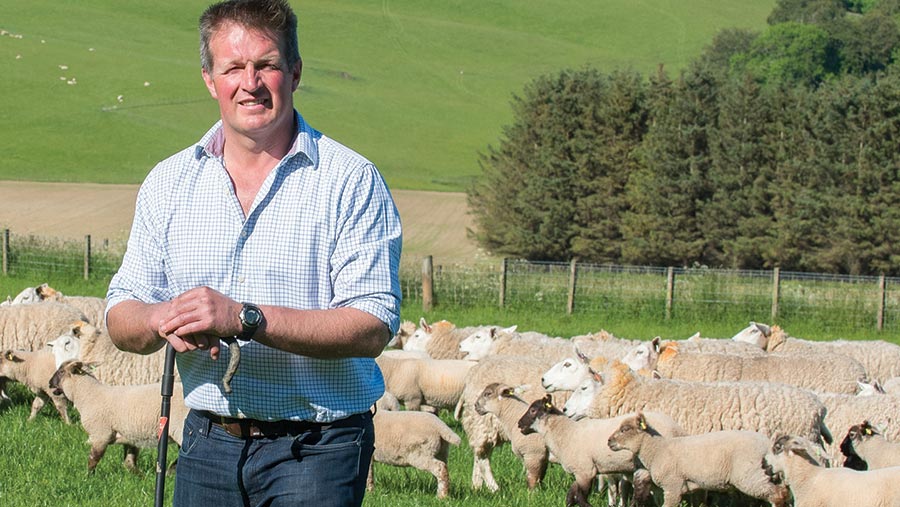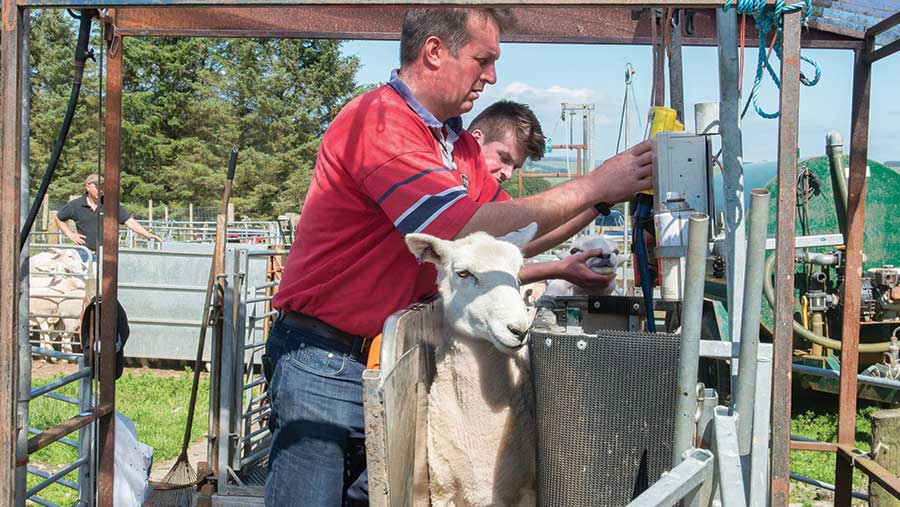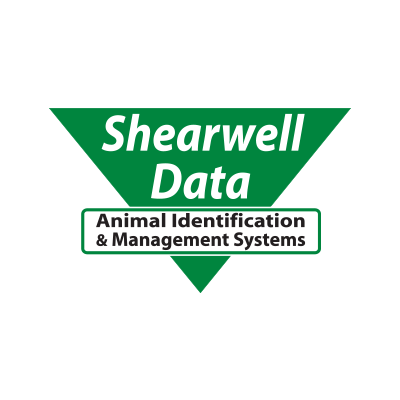How Borders flock is using targeted selective treatments
 James Logan, Galashiels, Scottish Borders © Angus Findlay
James Logan, Galashiels, Scottish Borders © Angus Findlay Selective treatments as part of a responsible wormer programme have seen a Scottish Borders farm slash ewe drenching and keep old actives working.
The Logans, who won Farmers Weekly’s Sheep Farmer of the Year 2019, leave a proportion of the fastest growing animals untreated in each mob.
This approach slows the rate of anthelmintic resistance by maintaining the susceptible worm population ‘in refugia’.
Lambs are weighed at every dosing via the flock’s electronic identification and weigh-head system and the fastest growing lambs are left untreated.
Farm Facts Pirntaton Farm, Galashiels
- 632ha, including 100ha of semi-native upland pasture and 100ha of woodland
- 1,800 commercial and 160 stud ewes, 120 suckler cows, 320 hinds
- New Zealand Romneys crossed to Abertex or Lleyn
- Lambs supplied to Woodhead Bros and ScotBeef
- Lambs outside for two cycles from 25 April
See also: Faecal egg count trial cuts wormer use on Welsh sheep farms
The farm has historically tried to follow best practice advice (Scops guidelines) and ensure at least 25 days between each dose to allow lambs to develop their own immunity and non-resistant worms to reproduce.
Dosing in lambs has fallen 5-10%, but adult sheep treatments have fallen to 2% of mature ewes last year, from everything being dosed six years ago.
Current worming rules
- Always dose with two separate actives to increase kill success rate and protect remaining effective wormer groups
- Never mix products
- Leave 5-10% in each lamb mob untreated
- Treat everything for Nematodirus – it can have a big impact on growth
- Only treat adult ewes if they are obviously being challenged by parasites
- An orange monepantel wormer is used as an early autumn “knock out” drench to help finish lambs and as a quarantine drench for bought-in tups
- A minimum period of 25 days between treatments, apart from spring Nematodirus when lambs may be drenched a second time 21 days later.
- Long-acting injections are solely used as a quarantine treatment and long-acting drenches are never used.
- Drenched sheep are never moved directly onto clean ground after treatment but allowed time to get re-infected for a few days to pick up susceptible worms.
Challenges
Pirntaton runs a “sheep heavy” system due to the steep topography of the farm. Sheep make up 60% of the livestock units, with deer accounting for 14% and cattle making up the remaining 26%.
“From a parasite control viewpoint we’d ideally be 50:50 and maybe even favour cattle, I think that’s a sweeter spot to be at from a holistic point of view,” explains Mr Logan.
The other challenge, shared with most flocks, is resistance to the (BZ-1) white group one (Albendazole, Oxfendazole, Fenbendazole) drench. However, this is still used in conjunction with another active and a higher proportion of lambs are left un-drenched.
The farm also uses (2-LV) yellow group two (Levamisole) and (3-ML) clear group three (Ivermectin, Moxidectin, Doramectin, Eprinomectin) drenches.

James Logan, Galashiels, Scottish Borders © Angus Findlay
Improvements
The Logans intend to increase the number of sheep un-drenched by using the Moredun TST protocol.
Part of the solution will be to conduct more drench efficacy testing and use the faecal egg count system FECPAK to monitor worm burden and wormer resistance.
Genetic parasite resilience/resistance is another area the farm hopes to capitalise on in future by buying in tups with estimated breeding values (EBVs) for wormer resilience.
Holistic farm management techniques
Use of mature ewes
Weaned mature ewes in good BCS are used to “mop-up” larvae in the autumn.
Use of silage ground
Post-weaning lambs produce the most worms. Lambs are weaned onto ground which will be used for silage the following season. Taking a silage crop off a field can be used to reduce worm burdens in that field.
Use of cows
Cattle follow ewes and lambs through the summer to clean up worms, or will be alternated on parts of the farm from one year to the next.
What does targeted selective treatments (TSTs) entail?
Moredun’s Dr Fiona Kenyon explains that the core aim of a Targeted Selective Treatments (TSTs) strategy is to only worm only when necessary and avoid blanket treatments.
Targeted Selective Treatments: The principles
- Every farm susceptible and resistant worms
- Resistant adult worms inside sheep will lay resistant eggs which hatch on pasture as resistant larvae which produce more resistant larvae.
- Whenever you treat, you kill only the susceptible worms inside the animal. The resistant worms are left to breed, increasing the genetic rate of resistance to the wormers.
- TSTs slow the rate of resistance by maintaining a mixture of susceptible and resistant worms on pasture.
Four ways to decide when to treat
Dr Kenyon says that the TSTs strategy is very broad and should be tailored to an individual farm, system and environment.
Sheep farmers have a variety of methods to decide when to treat stock.
Not every step needs to be carried out at once but combining several approaches will give a better picture of parasites at individual and flock level.
1. Dose according to DLWGs
Benchmarking a lamb’s growth against the mob average to see if a lamb needs worming, for example, opting to worm a lamb that is averaging 190g/day while the mob is averaging 240g/day.
The benefit of this approach is lambs with resilience to worms that carry on growing well are not wormed.
Drawbacks of method
- Growth rate can be arbitrary and alter through the year and from season to season.
- Moredun is trialling a pasture budgeting system to predict growth by using in-house software to forecast DLWG for each individual animal from grass dry matter cover data and grass quality. This approach has cut wormer use 40-50% on research and commercial farms with no negative effects on lamb weight gain.
2. Carry out Faecal Egg Counts (FECs)
A range of FEC services are available within the industry. FECs work by taking individual samples and extrapolating the results to be representative of the whole flock. It is then possible to gauge how worms are limiting flock performance.
This approach can identify three distinct worm families (Nematodirus, strongyles and Strongyloides) so treatment can be tailored accordingly.
Worm burden is measured in eggs per gram (epg) and thresholds vary between worms species.
Drawbacks of method
- With Nematodirus larvae, production-limiting effects are already being seen before adult worms have laid eggs and an increase in FEC can be identified.
- Egg-shedding rate varies from animal to animal and different worm species shed differently. Sheep resilience to worms is genetic.
- Parasite prevalence varies throughout the year. Nematodirus (spring, when temperatures first average 10C); Teladorsagia circumcincta (mid-summer onwards); Trichostrongylus (often seen in autumn, but being seen earlier and can persist through mild winters)
3. Carry out a visual assessment
Check the animal’s backside and give a dag score (one = clean, five = excessively mucky) to assess which ones are being affected by worms.
Drawbacks of method
- A visual assessment is rather subjective and depends on personal experience
- Lambs could be scouring or off colour because of a virus, bacterial infection or nutritional factors.
4. Famacha score
A Famacha score is a score given to a small ruminant’s eyelid as a measure of anaemia in relation to worms, particularly the Barber’s Pole Worm. (Haemonchus contortus).
A five-point scoring system grades the colour of the membrane. Animals below a certain score are treated. Specific colour charts and instructions are available, and some training is required before using this system.
Drawbacks of method
- Can be time-consuming in larger flocks
- Only works on Barber’s Pole Worm (Haemonchus contortus)
About Farmers Weekly Awards 2020
 The Farmers Weekly 2020 Sheep Farmer of the Year Award is sponsored by Shearwell.
The Farmers Weekly 2020 Sheep Farmer of the Year Award is sponsored by Shearwell.
Join Farmers Weekly in celebrating the farming industry and recognising the hard work of UK farmers and enter the awards today.
Alternatively, nominate a deserving individual for an award.
For more information about the Farmers Weekly Awards 2020, pay a visit to the official website.
